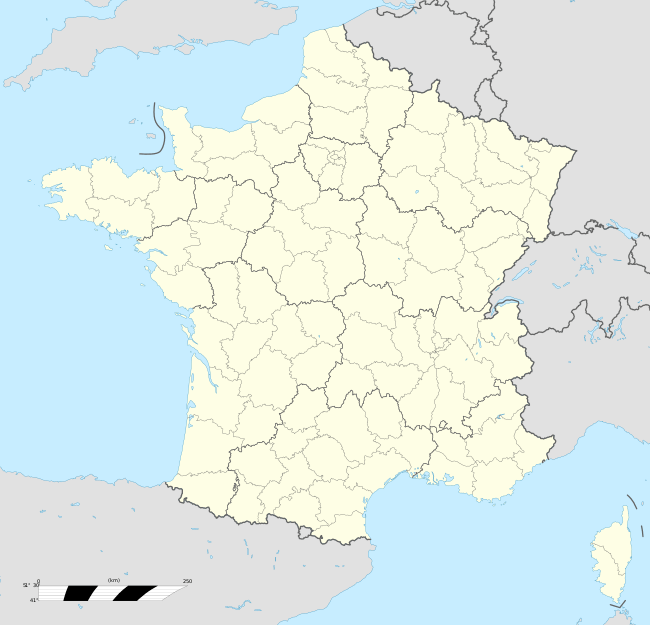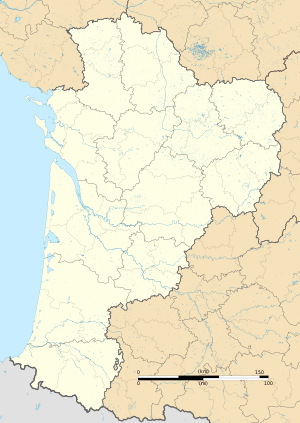Altillac
| Altillac | ||
|---|---|---|
| Commune | ||
 The Town Hall of Altillac | ||
| ||
 Altillac Location within Nouvelle-Aquitaine region  Altillac | ||
| Coordinates: 44°58′40″N 1°50′48″E / 44.9778°N 1.8467°ECoordinates: 44°58′40″N 1°50′48″E / 44.9778°N 1.8467°E | ||
| Country | France | |
| Region | Nouvelle-Aquitaine | |
| Department | Corrèze | |
| Arrondissement | Brive-la-Gaillarde | |
| Canton | Argentat | |
| Intercommunality | Canton de Mercœur | |
| Government | ||
| • Mayor (2014-2020) | Robert Vialard | |
| Area1 | 25.23 km2 (9.74 sq mi) | |
| Population (2014)2 | 864 | |
| • Density | 34/km2 (89/sq mi) | |
| Time zone | UTC+1 (CET) | |
| • Summer (DST) | UTC+2 (CEST) | |
| INSEE/Postal code | 19007 /19120 | |
| Elevation |
136–502 m (446–1,647 ft) (avg. 146 m or 479 ft) | |
|
1 French Land Register data, which excludes lakes, ponds, glaciers > 1 km2 (0.386 sq mi or 247 acres) and river estuaries. 2 Population without double counting: residents of multiple communes (e.g., students and military personnel) only counted once. | ||
Altillac (Altilhac in Occitan) is a commune in the Corrèze department in the Nouvelle-Aquitaine region of central France.
The inhabitants of the commune are known as Altillacois or Altillacoises[1]
Geography

Altillac is a large commune located in the central massif of the Dordogne in the extreme south of Nouvelle-Aquitaine. It was formerly called Xaintrie.
It is located some 30 km south-east of Brive-la-Gaillarde, 130 km south-west of Clermont-Ferrand, and about 180 km east of Bordeaux. Access to the commune is on road D940 which goes to the village just 1 km east of Beaulieu-sur-Dordogne then continues south through the commune to Biars-sur-Cere. The D116E branches south-east from this road to join the D14 east of Gagnac-sur-Cere. There is also the D116 coming from Brivezac in the north and the D41 highway to La Chapelle-Saint-Géraud in the north-east.[2]
The Dordogne river forms the western boundary of the commune with some streams from the commune flowing into it including the Ruisseau du Suquet. The eastern border of the commune is formed by the Ruisseau d'Orges which flows south into the Ceres river. The northern border is formed by the Ruisseau de Chauvac which flows west into the Dordogne. The Ruisseau de Laumond on the eastern side also flows east into the Orges as does the Ruisseau de Malaval in the south.[2]
There are quite a number of villages and hamlets in the commune. These are:
- Andole
- Courbignac
- Esclaux
- Fontmerle
- Freyssignes
- Gramond
- Guilles
- L'Aumond
- L'Aussac
- La Borderie
- La Bourelle
- La Majorie
- La Palide
- La Poujade
- La Poulvelarie
- La Veyssiere
- Le Rodal
- Le Sagrier
- Le Treil
- Les Escures
- Paliole
- Siran
Neighbouring communes and villages[2]
History
Altillac was the seat of a Viguerie under the Carolingian dynasty.[3]
On 28 May 1942, the regional prefect of Limoges requisitioned land from the Chateau of Doux to create an internment centre for Jewish families.[4][5]
Heraldry
.svg.png) |
The official status of the blazon remains to be determined.
Blazon: |
Administration
List of Successive Mayors of Altillac
| From | To | Name | Party | Position |
|---|---|---|---|---|
| 1808 | 1834 | Antoine Dauvis Bichiran | ||
| 1834 | 1837 | Jean Frédéric Bichiran | ||
| 1837 | 1878 | Jean Joseph Fontanille | ||
| 1878 | 1883 | Jean Baptiste Victor Borie | ||
| 1883 | 1884 | Joseph Lebrun | ||
| 1884 | 1885 | Jules d'Humieres | ||
| 1885 | 1888 | Jules Argueyrolles | ||
| 1888 | 1904 | Philippe Dounier | ||
| 1904 | 1908 | Louis Lamond | ||
| 1908 | 1919 | Jean Versejoux | ||
| 1919 | 1934 | Ernest Faugere | ||
| 1934 | 1944 | Georges Mas | ||
| 1944 | 1945 | Romain Conche | ||
| 1945 | 1958 | Georges Mas | ||
| 1958 | 1977 | Romain Conche | ||
| 1977 | 1983 | Robert Audrerie | ||
| 1983 | 1995 | Pierre Poulvelarie | ||
| 1995 | 2001 | Jean-Claude Vergne | ||
| 2001 | 2020 | Robert Vialard |
(Not all data is known)
Demography
In 2010, the commune had 854 inhabitants. The evolution of the number of inhabitants is known through the population censuses conducted in the town since 1793. From the 21st century, a census of municipalities with fewer than 10,000 inhabitants is held every five years, unlike larger towns that have a sample survey every year.[Note 1]
| 1793 | 1800 | 1806 | 1821 | 1831 | 1836 | 1841 | 1846 | 1851 |
|---|---|---|---|---|---|---|---|---|
| 1,544 | 1,290 | 1,685 | 1,576 | 1,794 | 1,870 | 1,805 | 1,894 | 1,914 |
| 1856 | 1861 | 1866 | 1872 | 1876 | 1881 | 1886 | 1891 | 1896 |
|---|---|---|---|---|---|---|---|---|
| 1,885 | 1,800 | 1,747 | 1,695 | 1,656 | 1,637 | 1,709 | 1,451 | 1,502 |
| 1901 | 1906 | 1911 | 1921 | 1926 | 1931 | 1936 | 1946 | 1954 |
|---|---|---|---|---|---|---|---|---|
| 1,419 | 1,378 | 1,333 | 1,135 | 1,143 | 1,081 | 1,023 | 938 | 860 |
| 1962 | 1968 | 1975 | 1982 | 1990 | 1999 | 2006 | 2010 | - |
|---|---|---|---|---|---|---|---|---|
| 781 | 762 | 720 | 791 | 824 | 801 | 833 | 854 | - |
Sources : Ldh/EHESS/Cassini until 1962, INSEE database from 1968 (population without double counting and municipal population from 2006)

Culture and heritage
Civil heritage
- The Chateau du Doux was built in 1904-1906 from plans by Jean-Louis Pascal. Influenced by the style used in Deauville, it is built in the style of Xaintrie, the nearest town, to serve as a luxury hotel. It is built above a valley and offers views of the surrounding landscape. Different styles are used for the window frames: simple windows, large curved bayss with stone latticework, cross windows, skylights, and capucine passantes. It used local materials to allow it to have a regional air: stones of various colours and a slate roof. Inside, the woodwork is Art Nouveau.[5]
- On the other side of the valley is the Doux domain where large farm buildings have been built: huge barns/stables on two levels with many barns built in imitation of small farms, which form a semblance of a hamlet, a henhouse, and a bread oven. All buildings - the hotel and the farm buildings - are certified as heritage of the 20th century.[5]
- The Dolmen de la Borderie - a Neolithic Dolmen in good condition.[6]
Religious heritage
- The Church of Saint-Etienne (14th century)

- A set of Baptismal fonts

- Covers for the Baptismal fonts (1700)

- Bowls for the Baptismal fonts (12th century)

- The panelling in the Choir (1676)

- 6 Bas-reliefs (1676)

- The panelling on the walls (1676)

- A set of Baptismal fonts
Notable People linked to the commune
- Jean-Antoine Marbot (1754-1800), General of the Army of the Republic, died in Genoa as a result of wounds received during the siege of the city. Father of Marcellin de Marbot.
- Jean Baptiste Antoine Marcellin de Marbot, General of the Empire and Baron of Marbot, more commonly known as Marcellin de Marbot (18 August 1782 in Altillac - 16 November 1854 in Paris). He inspired Arthur Conan Doyle and also published his own Memoires.
- Marcel Conche, born 27 March 1922 in Altillac, French philosopher and professor emeritus of philosophy at the Sorbonne
See also
External links
- Altillac official website (in French)
- Altillac on the old National Geographic Institute website
- Altillac on Lion1906
- Altillac on Google Maps
- Altillac on Géoportail, National Geographic Institute (IGN) website (in French)
- Altillac on the 1750 Cassini Map
- Altillac on the INSEE website (in French)
- INSEE (in French)
Notes and references
Notes
- ↑ At the beginning of the 21st century, the methods of identification have been modified by law No. 2002-276 of 27 February 2002 Archived 2016-03-06 at the Wayback Machine., the so-called "law of local democracy" and in particular Title V "census operations" which allow, after a transitional period running from 2004 to 2008, the annual publication of the legal population of the different French administrative districts. For municipalities with a population greater than 10,000 inhabitants, a sample survey is conducted annually, the entire territory of these municipalities is taken into account at the end of the period of five years. The first "legal population" after 1999 under this new law came into force on 1 January 2009 and was based on the census of 2006.
References
- ↑ Inhabitants of Corrèze (in French)
- 1 2 3 Google Maps
- ↑ Préfectoral decree of 27 August 1975, French Ministry of Culture Notice PA00099650 Altillac (in French)
- ↑ Château du Doux
- 1 2 3 Colette Aymard (Director of Publication), Architecture and Heritage of the 20th century in Corrèze, Direction régionale des affaires culturelles du Limousin, 2010, p. 1-2 (in French)
- ↑ Megaliths
- ↑ Ministry of Culture, Mérimée PA00099650 Church of Saint-Etienne (in French)

- ↑ Ministry of Culture, Palissy PM19001279 Set of Baptismal fonts
(in French)

- ↑ Ministry of Culture, Palissy PM19000828 Covers for the Baptismal fonts
(in French)

- ↑ Ministry of Culture, Palissy PM19000498 Bowls for the Baptismal fonts
(in French)

- ↑ Ministry of Culture, Palissy PM19000006 Panelling in the choir
(in French)

- ↑ Ministry of Culture, Palissy PM19000692 6 Bas-reliefs
(in French)

- ↑ Ministry of Culture, Palissy PM19000691 Panelling on the walls
(in French)

| Wikimedia Commons has media related to Altillac. |